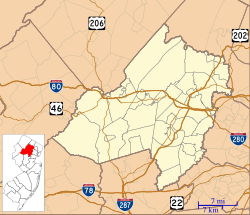The Normandy Park Historic District is a 57-acre (23 ha) historic district located along Normandy Parkway, between Columbia Turnpike and Madison Avenue, in the Convent Station section of Morris Township in Morris County, New Jersey.
Normandy Park Historic District | |
 The Red House at 20 Normandy Parkway | |
| Location | Normandy Parkway, between Columbia Turnpike and Madison Avenue Morris Township, New Jersey |
|---|---|
| Nearest city | Morristown, New Jersey |
| Coordinates | 40°47′31″N 74°27′10″W / 40.79194°N 74.45278°W |
| Area | 57 acres (23 ha) |
| Architect | George Augustus Mills; Robert C. Walsh |
| Architectural style | Late Victorian, Late 19th And 20th Century Revivals |
| NRHP reference No. | 96001469[1] |
| NJRHP No. | 3389[2] |
| Significant dates | |
| Added to NRHP | December 6, 1996 |
| Designated NJRHP | September 30, 1996 |
It was added to the National Register of Historic Places on December 6, 1996, for its significance in architecture and community planning. The district has 17 contributing buildings and 9 contributing objects.[3]
History and description edit
Normandy Park is an upscale residential development of villa estates located near Morristown. It was designed by John Dodd Canfield (1845–1910), starting in 1885. George Augustus Mills, a local carpenter, contractor and architect, built many of the first buildings. The district includes examples of Queen Anne, Colonial Revival, and Tudor Revival architectures.
The Red House at 20 Normandy Parkway was built c. 1900 and features Georgian Revival architecture. The house, owned by James Henry Coghill, Sr., was designed by Morristown architect Robert C. Walsh. In 1891, Henry E. Woodward built a summer residence here, which he name Fairacres. It was later bought by Charles F. Clark, president of the Bradstreet Company, now Dun & Bradstreet. His daughter, E. Mabel Clark, used the house until her death. It was later demolished and a new house built on the property in 1955.[3]
See also edit
References edit
- ^ "National Register Information System – (#96001469)". National Register of Historic Places. National Park Service. November 2, 2013.
- ^ "New Jersey and National Registers of Historic Places – Morris County" (PDF). New Jersey Department of Environmental Protection - Historic Preservation Office. September 29, 2022. p. 14.
listed as the Normandy Park Historic District
- ^ a b Benton, Suzanne (January 1996). "National Register of Historic Places Inventory/Nomination: Normandy Park Historic District". National Park Service. With accompanying 19 photos
External links edit
- Media related to Normandy Park Historic District at Wikimedia Commons
- "Normandy Park Historic District". Morris Township, New Jersey.


